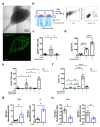Sympathetic neuron-associated macrophages contribute to obesity by importing and metabolizing norepinephrine
- PMID: 29035364
- PMCID: PMC7104364
- DOI: 10.1038/nm.4422
Sympathetic neuron-associated macrophages contribute to obesity by importing and metabolizing norepinephrine
Abstract
The cellular mechanism(s) linking macrophages to norepinephrine (NE)-mediated regulation of thermogenesis have been a topic of debate. Here we identify sympathetic neuron-associated macrophages (SAMs) as a population of cells that mediate clearance of NE via expression of solute carrier family 6 member 2 (SLC6A2), an NE transporter, and monoamine oxidase A (MAOA), a degradation enzyme. Optogenetic activation of the sympathetic nervous system (SNS) upregulates NE uptake by SAMs and shifts the SAM profile to a more proinflammatory state. NE uptake by SAMs is prevented by genetic deletion of Slc6a2 or inhibition of the encoded transporter. We also observed an increased proportion of SAMs in the SNS of two mouse models of obesity. Genetic ablation of Slc6a2 in SAMs increases brown adipose tissue (BAT) content, causes browning of white fat, increases thermogenesis, and leads to substantial and sustained weight loss in obese mice. We further show that this pathway is conserved, as human sympathetic ganglia also contain SAMs expressing the analogous molecular machinery for NE clearance, which thus constitutes a potential target for obesity treatment.
Conflict of interest statement
The authors declare no competing financial interests.
Figures






Comment in
-
Obesity: Specialized macrophages contribute to obesity.Nat Rev Endocrinol. 2017 Dec;13(12):690. doi: 10.1038/nrendo.2017.141. Epub 2017 Oct 23. Nat Rev Endocrinol. 2017. PMID: 29052589 No abstract available.
-
Macrophages dispose of catecholamines in adipose tissue.Nat Med. 2017 Nov 7;23(11):1255-1257. doi: 10.1038/nm.4440. Nat Med. 2017. PMID: 29117176 No abstract available.
-
Play It Again, SAM: Macrophages Control Peripheral Fat Metabolism.Trends Immunol. 2018 Feb;39(2):81-82. doi: 10.1016/j.it.2017.12.004. Epub 2017 Dec 28. Trends Immunol. 2018. PMID: 29290566
References
MeSH terms
Substances
Grants and funding
LinkOut - more resources
Full Text Sources
Other Literature Sources
Medical
Molecular Biology Databases

